Trust me, I'm in advertising...

10 years ago when I started my own agency, an account director mate left the industry to become a real-estate agent. I remember thinking it was the only place he could go that had a lower standard of trust than we advertising types.
Last week he told me it was a great move financially, he reckons 99% of people in advertising are really smart, whereas he’s happy competing with the 99% of real estate agents he’s found to be really ordinary. If we are that smart, why can’t we lift our own profile, beyond the bottom of the heap for trusted professions?
Trust in advertising? This is not an oxymoron.
Unfortunately, the perception of our industry is on a par with used car salesmen, yet our legal obligations, indeed our personal liability, dictate our practices are squeaky-clean.
In Australia, like most things, our industry is regulated and kept on the honest path by a series of laws and regulatory bodies. You wouldn’t know it.
The 2011 senate inquiry into outdoor advertising standards found only 0.01% of ads were found to be bad, i.e. sexist, likely to offend or straight out untruthful. Yet when prompted on ABC radio, the senator leading the inquiry said that if we don’t clean up our act under self regulation, he’ll "pull out the big stick and regulate" us.
Would you trust a politician to decide whether marketers are trustworthy?
In Europe, clergy are experiencing a decline in confidence levels and politicians are in last place. Our peers don’t rate much better than we do here, with over half of Europeans surveyed* saying they don’t like journalists, marketing specialists or advertising experts.
*Source: GfK Trust Index in spring 2010
I can understand why journalists are suddenly on the nose – the phone hacking scandal at Rupert's tabloid News of the World has in the words of one shareholders action group "laid bare a striking lack of stewardship and failure of independence." The board had been unable to set a "strong tone-at-the-top" about unethical business practices.
Australians generally are a trusting lot. When it comes to believing what our fellow citizens say, Australia on a trust index score of 92 ranks ahead of the U.S. (78.8) and U.K (61), just behind New Zealand (102) and way behind China on 120.9.

Source: ASEP/JDS data bank 2011
So where do Australia’s “ad people” sit on the trust index today?
Who we really trust is no real surprise:
1. Paramedics
2. Firefighters
3. Pilots
4. Rescue volunteers
5. Nurses
At the bottom of the pile are
41. Taxi drivers
42. Real estate agents
43. Car salesmen
44. Politicians
45. Tele-marketers
Source: Readers Digest Austrlalia’s most trusted professions poll 2011
Before you think ad madmen aren’t so bad after all, the only reason they’re not last on this list is because they aren’t included in the survey. Tele-marketers are the closest category, so let’s just accept advertising and marketing guys are way down there. How did we end up down at the bottom with pollies, and what do we need to do to elevate our role to a similar level of respect as other service providers like engineers, doctors and architects?
Advertising first took off in America in 1800s when snake oil makers discovered the return on investment of promoting something of little value with amazing claims in the press. In Australia last year the most damage to our credibility was the public complaints about the posters advertising Advanced Medical Institute’s cure for under performance in bed. It was bad enough they were bad ads, the real breach of trust was the pitch was a fraud. Most of those with a desire to last longer in bed were overcharged for a treatment that generally didn’t deliver on the promise.
As a professional I feel we would be better off refusing to work for these types of people. It didn’t harm Bill Bernbach’s career when he told prospects he wouldn’t accept their business if their product didn’t live up to his standards.
(Glenn Mabbott would like to declare his interest as a sitting member of The Communications Council’s Policy Committee, which aims to raise industry standards through the Accreditation Scheme. UNOmarcomms was one of the first independent agencies in Australia to gain accreditation.)
Are today’s retail ads bland, bland, bland?

Are today’s retail ads bland, bland, bland? This was the question posed by AdNews last week after Dick Smith launched a new brand style ad campaign. If you missed it, here is a cut down of my contribution to the debate.

Dick Smith was an innovator
He built a new category with advertising and brochus that gave Australia’s cardigan wearing tinkerers access to an Alladin’s cave of electronics stuff to play with in their garages. What proved Dick really clever was his ability to sell his growing challenger brand to Woolworths and then go on to innovate time and again. With Australian Geographic and then his Australian Made products, Dick was a natural at creating marketing campaigns that resonated with the public mood of those times.
Contrast this with another retail innovator of Smith’s era, Gerry Harvey. Gerry also made his first million in his early twenties with ads for whitegoods and appliances that yelled, “Why pay more?

Is Gerry a clever Dick?
Gerry didn’t sell his business and continues to be the biggest retail advertiser in the country with ads that follow the same tired formula of thirty years ago. We all know the pitch: yell loud enough and people will rush in to grab a bargain. Except increasingly we’ve learnt to treat those ads as repetitious nagging. We’ve moved on to better retail experiences, which are likely to be online.
It’s time the majority of retailers looked at the current crop of retail innovators, like Net-a-Porter that has just released a new magazine iPad app that makes shopping an exciting, contemporary experience. Or this great campaign in Korea for Tesco’s challenger brand, Home Depot.
This article first appeared in AdNews, 21/10/11
A lateral way to increase retail shelf space: use a billboard
Watch this short video of how Tesco challenged the number 1 retailer in Korea by creating a virtual store.
What’s the next killer app?
The latest stats show Australians are the number 2 adopters of smartphones. And this year, Tablets and iPads are set to outsell mobiles, Australians will buy 1.2 million of them*. In the last couple of years the fastest increase in marketing online has been with using video, so we believe the next big thing for marketers will be video over smart mobile devices.

Ask us about the app factory that will let you make the most of video content. (Soon to be launched by UNO with our partners at Mass Media Solutions.)
*Telsyte mobile device update 2011.
73% of CEOs think marketers "Lack Business Credibility"
According to damning research by the Fournaise Marketing Group, marketers are not the business growth generators they should be.*
The gist of the findings of an Asia wide survey of CEOs is that management believe their own marketing departments are in a world of their own. They believe marketers speak in jargon and are not contributing any value to the business. From my experience you can’t blame most business owners for thinking this way, especially in Australia. Too few businesses have ever had a good marketer sitting round the table at board level, championing the power of marketing to generate wealth.
Marketers need to talk the language of business outcomes
As in “how can marketing get a better return on investment”. Otherwise marketing will remain a misunderstood black art not worthy of the attention of three quarters of CEOs. The vast majority of businesses will thus miss out on the huge opportunities that insightful marketing can deliver when it is woven through the entire business process.
Meanwhile there are a handful of businesses doing better than the rest because they have value-adding marketers on the team. These marketers, obsessed with return on investment, are recognised as an integral part of the senior management team. They are helping their businesses punch above their weight in the following ways…
- Overcome competition based purely on price
- Prevent decline of sales
- Hold on to existing customers
- Build qualified sales leads
- Change the perceived quality of a product
- Revitalise tired brands
- Boost staff morale
- Speed the development of new markets
- Speed product trial and acceptance
- Help businesses raise capital more easily
- Build the value of a business for sale
ROI marketing works
For 100 years Coke has proven it, people from first world countries to third choose Alabama’s black sugar syrup even though it doesn’t taste as good as Pepsi’s. That’s the power of consistent marketing. Perrier taught us to pay more for mineral water than petrol. Branson has convinced Australians to fly Virgin despite having a deplorable record of taking off late, (and you still have to pay for your sandwiches). And thanks to marketing Apple has built a brand that is hugely profitable, marketing has enabled them to sell often inferior spec’d products at a premium to specialist manufacturers like Nokia and HP.
CEOs needn’t fear marketing speak. Business decision makers who embrace marketing with an open mind can still enjoy a sense of control by implementing a test and learn approach. Any marketer worth listening to understands the value of having the results of their work tracked. If it isn’t measured, it isn’t managed. A marketing program that IS managed WILL deliver better results than mindlessly sticking to what the company has always done, or jumping blindly into the latest thing.
ROI Marketing can make a big difference to any sized business, in any category
So what can ROI marketing do for you? My experience has shown me whatever the category, from Watties baked beans to Brita water, Splash Clinic cosmedical treatments to City Index CFDs, a test and learn marketing program can turn good businesses into category leaders.
Read MoreTwo thirds of Australians are using social media. Two thirds of those use it to decide what to buy.*
Social Media Marketing (SMM) is growing, the latest figures show Social Media is becoming a mainstream influence in the purchase decision process. UNO are members of the Australian Interactive Media Industry Association. Together with Sensis, AIMIA surveyed 803 Australian consumers and 1,944 Australian businesses to determine how social media channels are being used. 50% of corporations now have a social media presence, the majority on facebook. Just 14% of small businesses use social media.
Proportion who have Social Media presence

Proportion who have Social Media presence

Social networking site usage by age and gender

Here are 10 ways you can make more of Social Media in your marketing communications mix:
- Start now for free. If your business is consumer facing, get a facebook page, it’s free.
- For B to B, skip facebook. Focus where business decision makers are active. Join LinkedIn. Follow relevant associations and groups, join industry forums and post comments on articles.
- Share your knowledge. Your business is your passion; tell it how you see it where you can add value to a conversation. No need to sell, just build your credibility as an expert and you’ll be increasing the standing of your businesses.
- Don’t post as anonymous. Out yourself. The CEO of a solar hot water manufacturing company follows chatrooms where plumbers share advice. His comments to tradies‘ questions demonstrate he’s in touch with his market. I suspect his competitors are unaware such forums even exist.
- Put someone in charge of your Social Media. Empower a person within your business who is passionate and keen to have a dialogue with customers. If you don’t have anyone internally, outsource.
- Tweet. Reinforce your position as an industry expert by tweeting and re-tweeting about relevant content that others have shared.
- Blog. Blogs and reviews have a big influence on buying decisions, with 63% of social media users reading reviews before making a purchase decision.
- Be regular. Respond quickly.
- Integrate social media. Integrate content with your promotions and product campaigns. Measure. Track.
- Video is the future. It’s the fastest growing area online because it’s easy to share. It’s not enough to post a television commercial on YouTube because no-one will look for it. Be creative, film an interview with an expert, or shoot a behind the scenes glimpse that showcases something you do well.
Social Media can deliver a measurable ROI. No wonder businesses are spending 5% of their marketing budgets managing and creating content for social media.
The good news is that any business that has collected data on their customers is sitting on their own potential gold mine. Rather than spend money trying to appeal to new prospects by running press or even online ads, you will get a much better return on investment by adding some intelligence to the way you manage your data.
Give your CRM some Data Intelligence
Most data is in such a mess it offers little insight to business owners. To turn it into a powerful tool to enable you to communicate with your customers requires a clean, intelligently organised database.
The place to start to release the value from the mountain of data you already have is to give it to an expert to wash it.
You’d be surprised how many emails and addresses are wrong, repeated or out of date. You can’t begin to measure response rates until you know the data you have is clean. It’s better to measure the response from 10,000 real customers than to assume you’re sending offers out to say 30,000 on a dirty list.
Once you have a clean list, your data then needs to be structured and categorized with the aim of maximising its usefulness for marketing purposes. There are then some things you can do straight away to not only deliver quick profits today, but also set you on the path to delivering what customers will want in the future.
Fast profits can come from testing and tailoring offers to:
- up-sell, getting customers to buy more valuable products from you
- cross-sell, encouraging them to add something else to what they usually buy from you
- increase purchase frequency, by building loyalty and giving them more reasons not to be tempted by your competitors
So get the experts in quick smart to professionally clean your data so you can secure the future of your business. Let those who continue to spend big to tempt new prospects pay the price.
Read More
What will it take for retailers to stay in business in this rapidly changing global economy? Futurist Ross Dawson commented in a recent blog that if you expect your business to look the same in 10 years as it does today, expect to be out of business.
Who’d have thought ten years ago that Woolworths would be the biggest owner of pubs and bottle shops today? Constant change is the only way to stay competitive, which explains why Woolworths just bought Cellarmasters for $340million. Kevin Luscombe recognises the future includes database marketing, Cellarmasters “will enable us to serve a whole new customer segment in terms of the direct marketing channel.”
eCRM drives online sales
Cellarmasters has the largest databases of drinkers of premium wines in Australia. For any competitor to stay in the premium wine business they’ll need to at the very least match the way they apply an eCRM program to their database.
Once a database has been professionally cleaned, you can start to mine your database and build a series of profiles of your customers. Using that intelligence will deliver a better ROI on your marketing. You’ll get a better result cross selling Pinot Gris to customers who are heavy purchases of Sauvignon Blanc. With profiles of your customers it becomes practical to promote a 20 case limited offer Coonawarra cleanskin, you simply email your regular purchasers of Cabernet. With data intelligence, while you offer a bonus with purchase of single malt to spirits drinkers, beer drinkers automatically receive a different offer.
Very few customers want to be constantly bombarded with promotions that are obviously being sent to the masses. They will reward targeted offers that demonstrate you understand them as an individual with stronger loyalty.
Your customers know what they like and will actually tell you what they want if you bother to track their behaviour, or quite simply ask them. Every marketing activity, from a mailer or catalogue to a visit to your store, each phone enquiry and every online order is an opportunity for you to measure what works and what can be improved.
ROI marketing will drive e-commerce
Every dollar you spend on marketing should and can be measurable. You don’t actually have to be a futurist to stay in business, with data intelligence you can keep track of where your customers’ needs are leading and continuously adjust and improve to keep up with them.
Read More
Bernard Salt earns a living as a demographer. That’s the art of taking research data and painting a picture of who we are and what we think and do. Before you tune out thinking he’s just another propeller head making money off the back of lies, damn lies and statistics, consider for a moment what you’d give as a business to know where the next big opportunity for making money is, before it happens.
How do entrepreneurs know where to invest today in what will be the sweet spot tomorrow? What did the savvy few who bought franchises in McDonalds in the eighties know? Or the food services that were ready to be part of café culture as we left tea drinking behind?
If you were a tea manufacturer in the 70s Australia’s demographics could have predicted that your volumes were about to decline. The move from a society of tea drinkers to the blossoming of café culture at the turn of this century was a consequence of something that happened in the 1950s. The wave of immigrants from Italy and Greece post war had kids, grew wealthy and infused our Anglo society with a Mediterranean café culture which saw Australians move onto the footpaths and embrace machiattos and cappuccino with biscotti in preference to sitting indoors with a cuppa Bushells and an iced Vovo.
At a Family Business Australia breakfast, Bernard explained the simple truth that the composition of Australia is what drives business growth. And decline. Seems obvious, yet even the high fliers at BHP and the big four banks pay Bernard to keep them abreast of what should be self evident. It’s easier to grow a business and be profitable in a category of growing demand than to compete for a share of a shrinking one.
Change managment – there's money in tea
Follow the demographic trends that will shape what Australians will look like in the next decade and consequently what consumers will be asking for. Today there is a shift away from European immigration to Asian as these stats on fastest growth and loss by place of birth show.

Prediction: Start thinking about tea and noodles not coffee and pasta.
Super was yesterday’s money maker
In the last decade the biggest growth in financial services has been in superannuation. The SMSF category has doubled its share to be the largest segment at huge cost to growth of retail funds as boomers take more interest in their money in super. Industry funds have also grown share with a low fee proposition and the locked in stream of contributions via the super guarantee levy from a membership base that traditionally wasn’t saving much. But that’s today’s boom business, tomorrow it will change, again because of a shift in demographics.
The makeup of working Australia is about to fall off a cliff, as the boomers retire and are replaced by… no-one:

The age at which boomers will retire, now on average 58, as well as the length they can expect to live has also profoundly changed in just a generation:

Prediction: Cashed up retirees who will live for 20+ years will want to travel, eat out, be entertained, live in a city apartment or by the sea and to pay for it all need a retirement pension plan that will last the distance. They’ll be looking at ETFs and annuities.
Bernard Salt has a pretty good idea of what tomorrow looks like. It’s up to you to see how you can position your business today to be ready to reap the rewards of a growing market category before it’s the next big thing.
Read MoreDoes your business have a brand policeman?
When did you last check your brand imagery and how consistently you are projecting your business to customers and stakeholders? Have you done a complete audit of all your “touch points”? Who in your company has the authority to enforce standards?
Large corporations have entire departments looking after how the image they present visually. They have realised the value created by consistent repetition of the company brand marks alongside the product or service it delivers.

Most businesses fail to present themselves as professionally as big brands and end up with a brand “look” that has more in common with a camel than a racehorse. This occurs organically, by allowing too many people to make piecemeal decisions every time something is needed.
There are so many pieces that make up the complete picture of your brand, from a new business card to printing a brochure or sending an email offer. Each is an opportunity to build brand “credits”, or a risk for someone to go off on a tangent.
A complete audit of all your brand “touch points” would cover:
• Internal signage
• Building signage
• Banners
• Vehicle signage
• Advertising
• Email signatures
• Website
• eNewsletter templates
• Fax formats
• Letterhead
• Business cards
• Presentation folders
• Flyers
• Sales force and sales kits
• Product sheets, warranty forms
• Order forms
• Invoices
• Branding on your products
• Point of sale
• Price tickets and notices
Setting brand standards with a professionally developed Style Guide
Brand guidelines (also called a Style Guide) should cover all of the things in the list, and have specific rules for each element. For instance, how your logo is used would cover these specifications:
Colours
• Print: CMYK or Pantone reference
• Digital: RGB
• Mono, reverse,
• Vector files for artwork production.
Size guidelines - how small can it still reproduce?
Usage guidelines - clear space, location on the page, hierarchy with other symbols.
A Graphic Designer with credentials in this area can produce your Style Guide.
Enforcing your brand style
Your creative agency can act as your deputy and arm you with a password protected online archive of logos, images, artwork formats and templates.
Many businesses also find having a professionally developed Style Guide available, as a reference document for staff and suppliers, helps enforce brand rules making it easier to keep the company image under control.
Finally, someone qualified within your company needs the power to enforce the Brand guidelines. It is possible to mandate that all work using the company brand mark is approved by this person before it goes into production.
Success through consistency
Every business can benefit from designing formal brand “rules” so they can weave simple and consistent imagery through the company’s everyday operations. If you have a good product your customers will come to associate that product with your consistently delivered brand mark.
Read More
There’s more to ecommerce than GST
Funny how Harvey Norman and other retailers are running to the regulator with the sob story that they are losing sales to overseas online providers who don’t pay GST. Time for a reality check, they are losing sales because they are slow in changing their business models to keep up with consumer behaviour. 6 months ago I flagged the stats showing how quickly online sales were growing and the failure of our retailers to keep up with the trend.

Consumers reward innovation
It’s how Gerry Harvey made his first millions when, in his twenties, he founded the first category killer electrical discount store, Norman Ross. You don’t have to be young to be innovative; you just have to give consumers what they want in new and exciting ways. Today consumers increasingly are researching and shopping online. In a few years what they want will be something most of us have yet conceived, and more than likely Apple’s Steve Jobs, aged 55, already has in development.
Facebook keeps growing. So how can you make the most of it?
Facebook has broken through the 10 million barrier of active users in Australia*
While this will prompt many to jump in and increase advertising on Facebook from the current $12million a year, content is the cost-effective way any marketer can gain exposure to this increasingly significant audience. Best make sure it's the right kind of content.
Online content is King
When publishers and marketers say content is king, what exactly do they mean? Here’s an example close to my home. When I was 20 I played occasionally in a punk band called The Coathangers. Most nights we were lucky to get paid in free beer, the cover charge might be a couple of bucks. One night we had 6 bands for 69c. It was accepted that routine you played for little or no immediate return to build up an audience. Later you would then sell records to them, which was where the money was. Your loyal following paid for content.
Today you can’t expect to sell many CDs when everyone can download your content for free. My 21 year old son has a new band, The Psychonaughts. They hardly ever play live, they are busy recording, creating content that will more than likely be given away. In the not too recent past a band would build a website that fans would visit to purchase songs and buy merchandise. Not any more, people expect everything online to be free.
So what’s the value of giving away content online?
In the case of music, the content gets passed around and builds an audience, who then pay to see you perform live. Technology has turned the model upside down.
The ease with which people can share content across social media is a lesson for brands – we are now in an era where you have to produce content of value to your target audience, making it available for free. It then requires like-minded prospects to share it by whatever medium they choose: YouTube, mobile-to-mobile, email, or increasingly, Facebook.
According to Facebook regional vice-president A/NZ Paul Borrud, globally two-fifths of the more than 500 million Facebook users are accessing the site through their mobile. And Australians spend longer on the site than anyone else.
Unlike marketing via your brand site, or Google adwords, or banner ads or traditional mass media advertising and PR, the consumer isn’t being paid to publish your message. For content to be spread it isn’t enough to post brochure copy or press releases, content needs to be engaging stuff that your customer sees value in. And by aligning this free content with your brand story you can build a relationship with prospects stronger than an advertising approach could ever achieve.
So the art is producing content that is worthy of the attention of your audience, something they want to share.
* SMH.com.au 10/12/10

You may have noticed late last year the AANA broadened their official definition of “advertising” beyond that of a paid-for message. To reflect the changes the Internet has brought about, they now refer to “marketing communication” activity as brands are now often engaging in two-way conversations, not just pushing messages one-way via ads.
Early this year CommBank’s CMO Andy Lark, an ex PR man himself, told PR agencies they risked losing their traditional area of expertise to digital experts and integrated agencies.
The issue for businesses isn't simply which external supplier or internal staff is running your social media. With new technology comes a lack of control over how customers choose to seek information and engage with you, which brings a new level potential for confusion. And just as there is confusion around whom within a company or it’s preferred communications partners should be in charge of the conversation, the laws we all operate under right now are equally confused.
Who is responsible for comments posted on your business Facebook page?
In response to an ACCC ruling and fine of a liquor brand for leaving comments on it’s Facebook page deemed to he inappropriate, the AANA extended the reach of its Codes to cover most forms of advertising and marketing communication over which the advertiser or marketer has a reasonable degree of control.
In two recent determinations dealing with brand-owned Facebook pages, the Advertising Standards Board (ASB) reflected the AANA’s intent and stated:
“The Board considered that the Facebook site of an advertiser is a marketing communication tool over which the advertiser has a reasonable degree of control and that the site could be considered to draw the attention of a segment of the public to a product in a manner calculated to promote or oppose directly or indirectly that product."
"As a Facebook page can be used to engage with customers, the Board further considered that the Code applies to the content generated by the page creator as well as material or comments posted by users or friends.”
While you may think this ruling is a bit rough, at least you know where you stand. Until this week.
The AANA at least gave clarity, we now have a contradictory new set of guideline by the IAB
“After a careful analysis of existing laws and regulation and industry practice around social media IAB Australia has reached the view that user comments directed towards an organisation or social media platform, or to other users who are drawn to a particular organisation, do not constitute advertising,”
According to Samantha Yorke, director of regulatory affairs at IAB, “There is a real risk that organisations who treat user comments as advertising will err on the side of caution and moderate user comments very conservatively, which will adversely impact their presence on social platforms and which arguably undermines the very spirit under which social media thrives,”
I wonder what a judge will say about a marketer’s immoderate management of a social media campiagn in a yet to be held ACCC hearing?
UNO is one of a small number of marketing communications agencies accredited by The Communications Council of Australia. We believe self regulation only works when all of our customers' messages within our control are held to the same highest standards of paid-for and signed-off ads, irrespective of whether published in a traditional, new or yet to be invented medium. At least that way our clients have minimised their risks, both known and unknown.
Read More
There are many tips and how to guides claiming they have the key to revealing the relative strengths and weaknesses of where to advertise, promote and connect. Media sales reps have a long history of presenting charts and graphs that show their medium in a favourable light. To ensure the best ROI marketing, we only rely on those studies that have rigorous methods and meaningful numbers to make the findings reliable.
Don't trust every media benchmark you can Google
For those who want to know what medium is most effective at acquiring new customers in the digital era, here is a chart we feel is valid:
Trend in performance of digital channels for acquiring new customers
Custora came up with these figures by analysing data from 72 million customers shopping on 86 different retailer sites. They tracked where customers were clicking from (email, Twitter, Google, etc.) and what and how much they bought, not just on that visit but for the next two years.
Over those two years, Custora found that customers who came to retailers from search were 50 percent more valuable than average. In other words, they were more likely to shop more and spend more. Email customers were nearly 11 percent more valuable than average. Customers who came through Facebook were just about average. Twitter customers, meanwhile, were 23 percent less valuable than the average during the two years following that first click.
I've written before that our reluctance to spend clients' money on banner ads is based on one amazing fact: you are more likely to win Lotto than click on a banner ad.
In comparison to these digital channels, research by the Direct Marketing Association shows you may still be best served with good old direct mail:
Average response rates for direct sales, DMA 2012
There is one new piece of research though that ultimately makes the discussions about differences between media effectiveness become a secondary consideration. It's proof of what many of us have always suspected.
How you craft your message is more important than the medium
The latest research into advertising effectiveness in Australia has proven creativity makes a big difference. The Association of Data-driven Marketing & Advertising shows that after 12 months ads with better ideas are both more effective and increase a brand's ability to harden pricing.
This reminds us you’re potentially wasting your time and money if you don’t get your pitch right. As consumers we remember big ideas, like “Think small.” Or the pulling power of a well crafted headline like “It’s Time.” Or a picture worth a thousand words...
The truth well told has been proven yet again to be more important in getting the best ROI from your marketing than any optimisation techniques digital specialists may dazzle the bean counters with. We are not animals, we are human, and we respond to emotions, not numbers of targeted exposures.
For those who want to make the most of their investment in airtime/space/or face-to-face, remember to invest a little in the art of communication.
It's not just consumer brands that can benefit from better communication
An ability to express your message is just as impotant for both service businesses and B2B. This is especially true for financial services, as shown by this chart of what customers say are the most important qualities in a financial adviser.
AFA White Paper: The Trusted Adviser May 2013
The report found the biggest difference in success of the top 10% of financial planners and the rest isn’t expertise, or credentials or technology – it’s the ability to communicate. Communication is not talking at people, it's the art of speaking with empathy. This is where social media excels. Use it to listen to your customers, then respond in a way that makes the individual believe you understand where they are coming from.
Irrespective of digital or traditional, face-to-face or in writing, where you have the conversation is secondary to the way you express yourself.
Just remember to make the message suit the medium. Our burping cow ring tone for Sipaah was downloaded by lots of kids who knew exactly where our brand was coming from.
Read MoreFame is the game of the name


The exponential pace of change is increasing the pressure on businesses to stay competitive. You know it’s not going to slow down. Fortunately there are still ways you can take control. One proven method is to revisit some simple building blocks to help make your brand relevant in today’s complex marketplace.
4 step process to make a challenger brand famous:
GAME
NAME
FAME
CLAIM
Game:
When did you last define what it is you do you do that makes you a specialist. In a cluttered business environment it pays to play in a defined niche where you know more about the rules of the game than your competition. Define the things that are of value to your prospect. Make sure you understand what it takes to be world’s best at your game, and work to stay at the top. People will still pay you a premium for something special that means something special to them.
With a fresh outside perspective, define your true differentiators, your “authentic truth.”
Name:
Your reputation, the brand and everything it does must be aligned with what you do that is special or your efforts will be diluted. Today, any business with integrity can compete against established incumbents. The cost of entry is no longer big budget mass media campaigns, the spoils now go to the nimble.
Today, the truth is what counts, the public can find the facts faster than businesses can attempt to shape opinion. Ensure your brand reflects your truth in everything you say and do.
Fame:
The art of being noticed. And remembered. And talked about.. You can do this several ways. Spend a lot of money, like Swisse, who invested up to 60% of annual revenue to marketing to achieve business growth, which stands at about 50% year-on-year over 4 years.
Or take the stand out in the crowd approach. An elevator pitch is only of value if people are listening, be too polite and you will be invisible. There is something to be said for the fart in a lift approach, however can you risk going viral with the wrong tone of voice?
Ideally, you can take the hero approach: be noticed by the right people for the right reasons. To do this ensure you choose the right medium for your message. There have never been so many communications options – a pitfall for the unwary, and an opportunity for the savvy
Claim:
Tell the truth, especially now the customer can search the Internet to discover what is a genuine claim and share with their friends what they find out. Decide what will differentiate you in your game – do you do it faster or smarter, cheaper or better?
Then find a creative way to express your difference. As J Walter Thompson said almost a century ago, “the truth well told” is the value add of great advertising.
Famous campaigns start with a defined customer benefit
What’s your “Which Bank?” How will you enter the vernacular, as this one of mine did 25 years ago:

With a creative leap, you can express the human insight that will resonate with your prospects. And they’ll repeat it to friends, again and again.
Read More


How do you explain to the manager who signs off your budget that today customers want more from your website than a brochure online? You can start by pointing out how you can replace existing fixed and recurrent costs with keener priced digital alternatives. Then remind the cost controller that technology is moving so fast they’ll be surprised how much more you can do today for less. A lot less than many of the savings to be made across existing business practices that digital can now enhance or replace. This 12 point digital checklist can help you keep it simple and the returns substantial.
Your digital project 12 point checklist
Keep an open mind, what the site needs to include is based on what the customer wants, don’t limit scope by prescribing whats to be included by your what your preconcievd ideas of what the competition have already done.
Engage with the user in the context of where and how they are accessing you. Are they on a mobile while in a shop, in bed on a tablet or at their workdesk on a PC? At work, at home, on the move, your site experience needs to change accordingly.
Educate or entertain? Ask yourself are they visiting your site to learn more, or simply because it is an enjoyable experience? Or would they like it if you did both? Deciding this helps shape your content and navigation.
Personalisation. "Allow users to personalise their experience. People love to add personal touches because it helps them feel at home and in control. Provide sensible, beautiful defaults, but also consider fun, optional customisations that don't hinder primary tasks." - Google Android
If you don't treat each customer as an individual, a competitor will. Technology now enables you to serve each visitor exactly what they want, a bespoke site just for them.
Innovate.The digitisation of everything now allows you to reinvent so many of your business functions and methods, take advantage of what is now possible.
Tone of voice is more important than what you say. The way the site looks, the colours used, typography, whether there are pictures or videos and the style of vocabulary you use will make a bigger impression about your brand image than what is in the text.
Services is what you build today, not websites. "Our service doesn’t begin and end at our website. It might start with a search engine and end at the post office. We need to design for that." - GOV.UK
Iterative, our most used word to describe our process for scoping, designing and building a digital service. Start small, constantly evolve and develop the service offer. We learn and improve the offer together as we go.
Marketing. A site without marketing is an island resort that’s not on any map, let alone an itinerary. Don’t launch and leave, have a plan that will drive customers and prospects to your site, align what the promise is and how your site will deliver to expectations.
P, there are 4 of them in marketing: Product, Price, Promotion, Place. Consider which of the Ps is most useful to enable you to best engage with each type of customer. The 4Ps of marketing aren’t all the same for every person or every occasion.
Load time is more important than looking good. Too many fancy things can slow down the experience.
"Make important things fast: Not all actions are equal. Decide what's most important in your app and make it easy to find and fast to use, like the shutter button in a camera, or the pause button in a music player." - Google Android
Effectiveness. Know what you want to achieve and why. Most importantly decide how you will measure with meaningful metrics that can be acted upon. Then you can build in measurement techniques to track what is working and what needs to be improved. And make sure someone is in charge of tracking results and implementing improvements.
If in doubt about what matters most, remember the customer's perspective comes first. Look at the first letter of our 12 points. In an increasingly complex world, when you connect with customers they will appreciate it of you can KEEP IT SIMPLE.
Read MoreRadioactive ads from when people didn't know better

Classic ads from 1910-1930 for radioactive products
What can’t radium cure? A century ago it was legal to advertise radioactive products, from toothpaste to suppositories, condoms and check out the chocolate!

If looks could kill: Radium lipstick advertisement from the 1930s. (via 109.com)
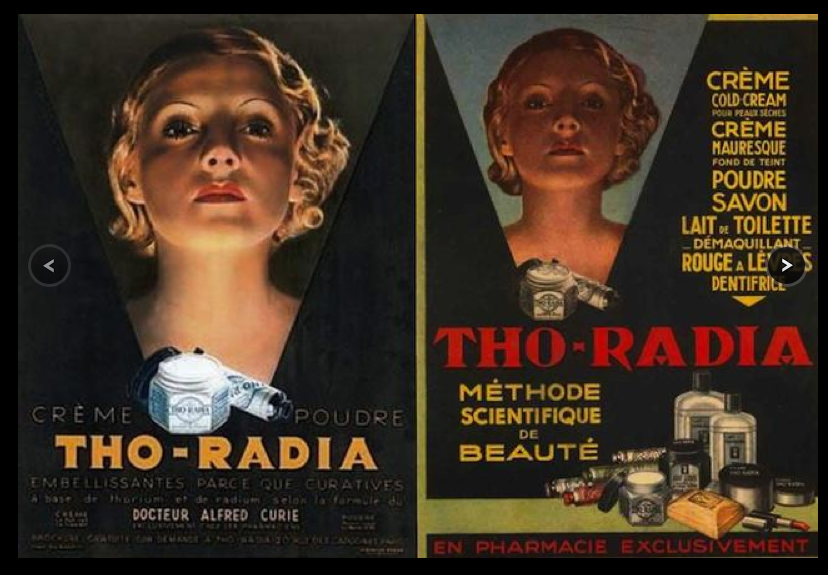
More classic ads from the 1930s for the Tho-Radia range of makeup.

Nil by mouth, guaranteed harmless?!! Gives new meaning to "the ring of confidence"
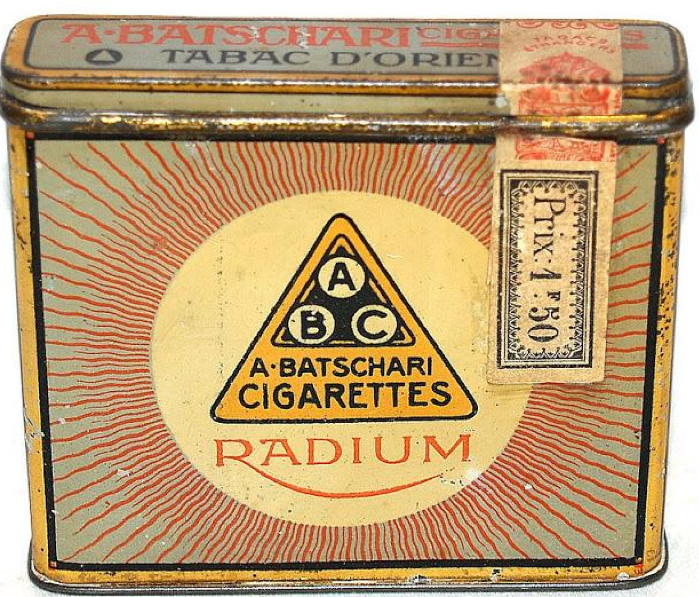
Anyhow, have a radium.
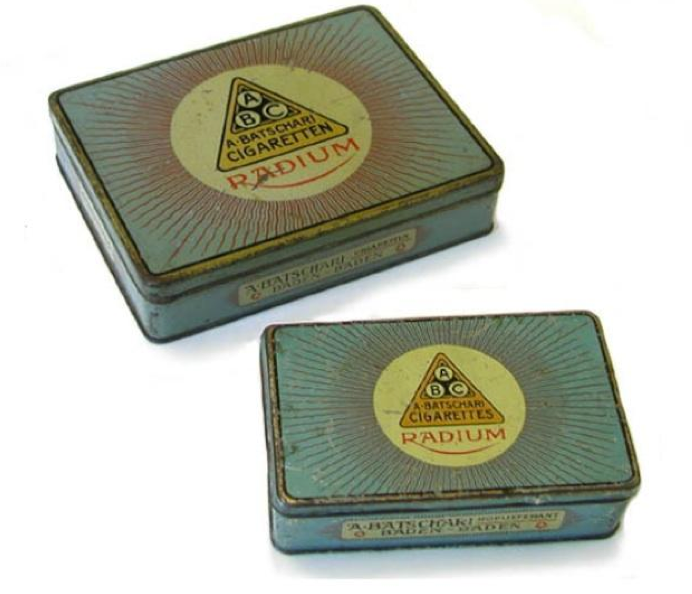
Now in a convenient pocket size pack of 20s. They didn't know smoking kills.

Mrs Marsh could give us a demonstration of the brighter effects on your smile of Radium toothpaste.

Chockaholics aren't left out, Radium is everywhere. The ads claimed eating a block would make you look younger.

Time wasn't on the side of those with radioactive numbered watches that glow in the dark.

Another ad campaign competing for share of the toothpaste that glows market, now with added thorium.

Radioactive wool keeps you warm on the slopes.
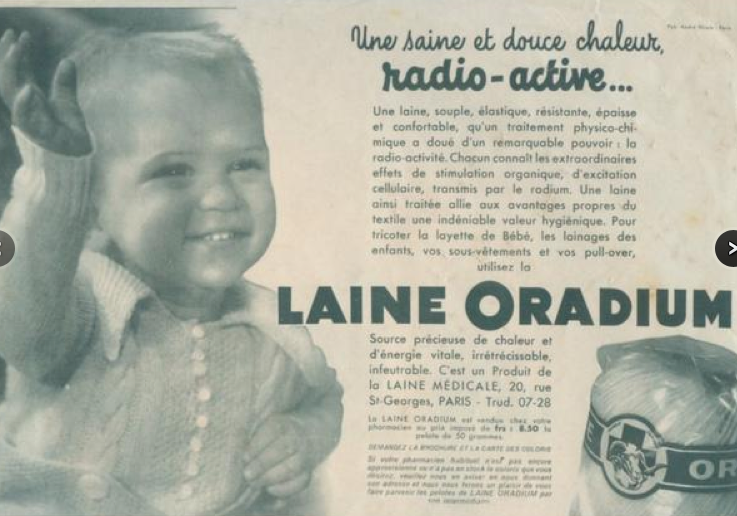
Dress your baby in it.

Advertised as a cure for arthritis, rheumatism, mental illnesses, stomach cancer and impotence. (via Real Food University and Oak Ridge Associated Universities) Triple distilled, who needs a whickey chaser?
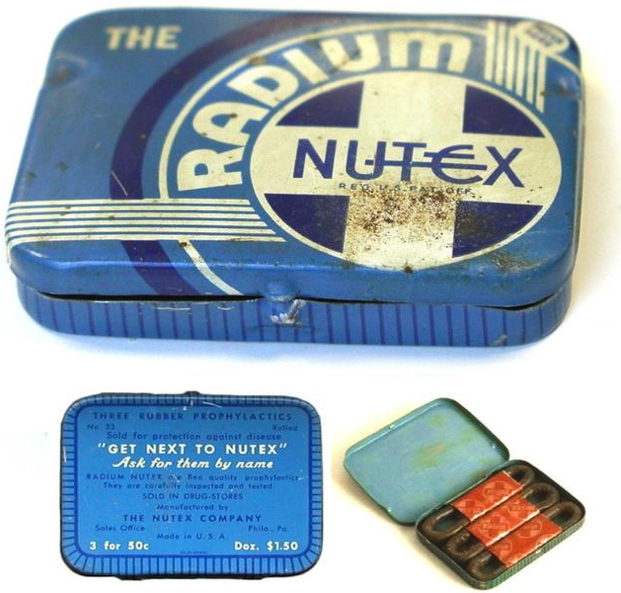
Condoms, that glow in the dark?
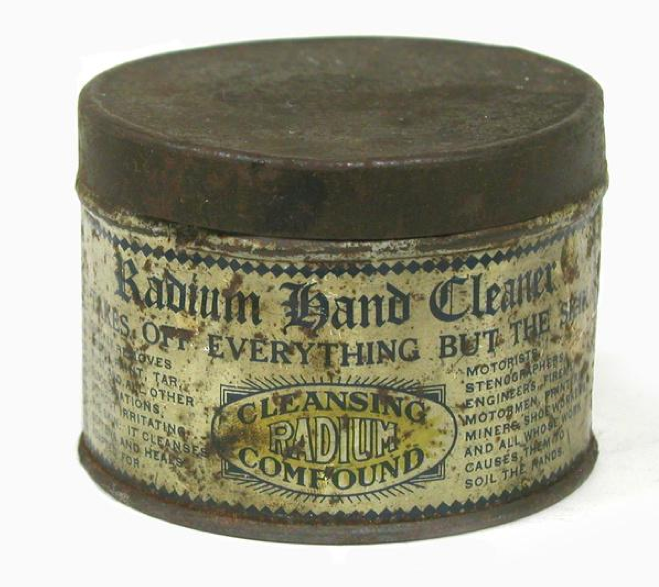
They didn't realise you can't wash off radiation poisoning.
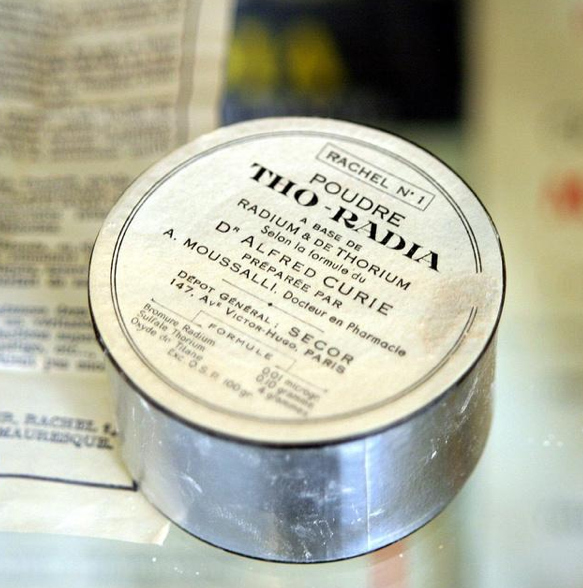
Dr Curie started something big. Cosmetics companies continue to claim they have the secret to eternal youth.
Like to see some more classic ads?
Have a look at 12 great vintage politically incorrect ads for Christmas gifts.
Read More
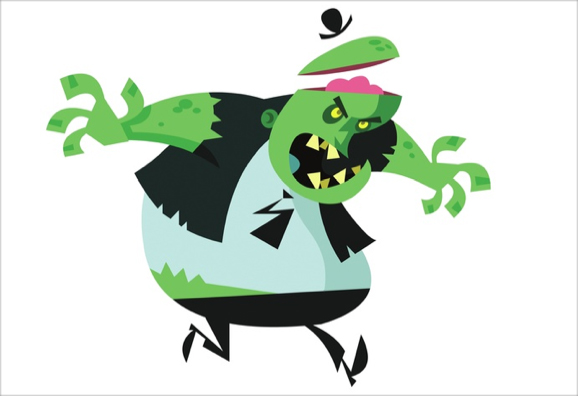
Everyone knows the way to lose weight is to eat less and exercise more.
Yet year after year most Australians are getting fatter. Fatter people aren’t as healthy. Fatter people die earlier than fitter, leaner people.
A whole industry makes money out of fat. Fitness clubs. Personal trainers. And diets. None of it works over time. The stats prove it. It’s not enough to know you have a problem. Personally I have never been better educated, yet I’ve never been so overweight.
Science has shown only cognitive behavioural therapy ensures long-term positive change and a healthier longer life as an ex-fatty. 21 days of mind reprogramming is just the start to breaking the usual fatso habits.
Business as usual doesn’t work. How long till the business you work for dies?
Australian businesses are fat. They aren’t fit enough to cope with today’s rapid pace of change and increasingly complex issues. They don’t exercise their brainpower by trying something new. And like most of us with a weight issue they are looking for the quick fix. So they outsource it.
The diet industry equivalent in this instance are the service providers, from the Deloitte pre-prepared meal programs and the peddlers of management boot camps, to the efficiency fitness trainers selling the benefits of Sigma 6 and Lean. Even the language is the same as The Biggest Loser.
The answer for struggling businesses isn’t in doing the same things more often, or paying more personal trainers to lift your motivation. Nor is it enough to reduce the excess fat by cutting costs. Stomach stapling the business results in staff suffering reflux, hunger pains and mental stress for no performance improvement.
The answer is cognitive behavioural change.
The answer is developing an innovation mindset.
Here’s how it works and why most businesses are doomed to die early.
It starts with the owners of the business recognising they have a problem. An attitude problem. Their brains have been thinking the same way so long their synapses have turned a well-worn groove into a rut of superhighway proportions. The problem is, it’s now a road to nowhere.
The new business opportunities aren’t where the brain has become accustomed to drive to, every category is seeing their marketplace become a ghost town. Today’s marketplace is somewhere new, and management not only don’t know where it is they don’t have a map to show them how to get there.
The new destination is growing, profitable and exciting. It’s enabled by the Internet and feeds on new ideas made possible by software as a service, unified comms and the cloud. The new place isn’t a city or a country or a category, it’s everywhere and anywhere the customer happens to be, 24/7. Now every customer or prospect can pick and choose what they want via a mobile device. From cat food to cars, retirement plans to restaurants, you can research and purchase without talking to a salesperson.
Yet business owners continue to think the value of their business is existing fixed assets and legacy systems, current supply contracts and distribution arrangements, proprietary processes and procurement systems. Australian managers continue to tweak a little here and there around the edges of their business models. Generally, the bigger the organisation the more cholesterol blocked the arteries of internal management and external communication.
Figuratively speaking, fat dead men walking the corridors of offices around the country are about to be knocked off by fit and nimble female and new age male entrepreneurial thinkers who are open source and open minded.
So what do our business leaders do? They buy another diet book, like the biography of Steve Jobs. What they don’t realise is reading about Apple is as relevant to middle managers as middle aged men reading about Usain Bolt’s exercise regime. Apple was a challenger brand from day one. It was in the DNA.
The answer isn’t reading a book on what someone else has done. It comes from doing what hasn’t been done. It comes from the confidence to try something new with a willingness to fail. Accepting you’re likely to fail again and again. Because continuing to do what you do now is guaranteed to fail. While with every new thing you try your chances of discovering a winner increases.
Changing your habits and practicing to do what doesn’t come naturally, every day, is the proven method for success. It’s making a habit of taking small risks often so you don’t stand still and become another Kodak. The proof is in understanding how Fujifilm could innovate itself a future as a cosmetics company.
Memories might be priceless, they just don’t make money like they used to.

How a traditional business became a challenger brand
Fifteen years ago Kodak entered a death spiral, from a global peak in 2000, camera film sales dropped 90 per cent in 10 years as the digital revolution swept the world. “We’d known it was coming since the 1980s,” says Yojiro Yamashita, general manager of Fujifilm’s life science products division.
Kodak didn’t make it, going bankrupt last year. Fujifilm not only survived but emerged into the digital world of today with a series of innovative new businesses.
Fuji recognised what its’ true strengths were says Tomoyuki Yamazumi, a cosmetics industry analyst for the research firm Fuji-Keizai. “It had the financial power plus a strong marketing ability and existing ties to consumers.” One of the small risks Fuji management took was launching a cosmetics range in 2007. By 2010, sales of Fuji’s upmarket Astalift brand were already over $100million a year. By 2018 the company is looking to increase skincare and supplement sales by ten times that.
Look around your business. Are you a Kodak, or can you recognise your strengths, try something new and innovate your way to a future as a challenger brand?
This article first appeared in AdNews, 30/5/13
Read More

At CeBit 2013, Salesforce Vice President Vivek Kundra’s big question for Australian leaders is “how can a country of 22 million people compete in a world of seven billion?” His answer?
“It’s not about size. It’s going to be about innovation. Innovation policy and an innovation agenda have to bethe come building blocks of a nation that’s going to compete in the global economy.”
Third wave of computing is changing the global economy
Competition in the global world of business is being driven by a ‘third wave of computing’. Essentially the shift from hardware to cloud based software and services and super fast mobile broadband networks that allow consumers and workers to access data on portable devices. Our clients have seen a doubling of visits to their websites from mobile devices over the last year. In fact, this year more people globally will access the Internet from a mobile than a computer.
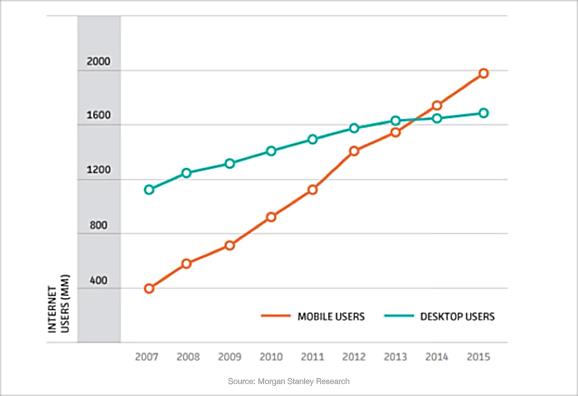
The opportunity for challenger brands
The biggest risk for businesses I’ve observed are the internal stakeholders defending their hard fought for legacy systems and infrastructure, and managers who are obsessed with efficiency through fine-tuning traditional methods. As Kundra points out, competitiveness now comes from letting go of what you’ve currently got now. “Most large scale organisations are still stuck in 1980s technologies. If you’re still stuck in an old mindset then unfortunately there’s a young entrepreneur who is imagining the way the world should be rather than it is.”
“The most amazing opportunities lie in reinventing entire sectors of the economy.” Vivek used the usual examples of US companies like Amazon, Netflix and Uber as businesses that are challenging categories today.
If you are running a business you have a clear choice he says – “do you want to be Amazon or Barnes & Noble?” This isn’t a particularly new view, as a global survey by Boston consulting summed up a couple of years ago, in this world of rapid change the spoils go to the nimble. Still, many managers still don’t seem to be responding.
“There’s a Darwinian spirit to the extinction of those who are holding onto the 1960s ways of doing business.” Vivek states, “not because it’s in the interest of the customer but because it’s easy and it’s because that’s what they know what to do.”
A marketer’s mantra for today: “The customer. The customer. The customer”
This is the biggest differentiator for challenger brands. “Companies that are embracing the third wave of doing business are doing it in the interest of the customer.”
Kundra recognises the fear of change within businesses when he suggests the best way to introduce a change culture is to build a prototype. “I think for too many people the expectations for transformative technologies is that it takes too long, costs too much and they’ve been burned in the past.”
A test and learn approach reduces risk
Last week at the launch of an AGSM Mid-Market program a professor specialising in innovation for business pointed out success today comes from having a portfolio of new initiatives that can be tested quickly in the marketplace. Rather than over researching only one strategy in an attempt to minimise risk, be willing to fail and fail frequently. The chances of some prototypes being winners with the customer will increase the more you try.
As Kundra says, aim to “be relevant and simplify the customers’ or citizens’ lives”.
Read More

The latest statistics on online fashion retail sales, research on the main purchase driver for financial advice and a Californian think tank pricing model all give marketers strong reasons to reconsider Price as a useful tool.
Evidence 1: Online fashion sales prove price not the motivator
No wonder Australian retailers are scared of online stores. British online retailer ASOS recently revealed that Australia is its single largest foreign market — with Australians buying something from the ASOS website every 6 seconds. The latest research from Roy Morgan shows at December 2012, 7.6% of Aussies aged 14+ (or 1,430,000 people) had made an online fashion purchase in any given four weeks — up from 5.7% (1,062,000) one year earlier.
Online fashion-purchasing habits by Australian women by sub-category, 2011-2012
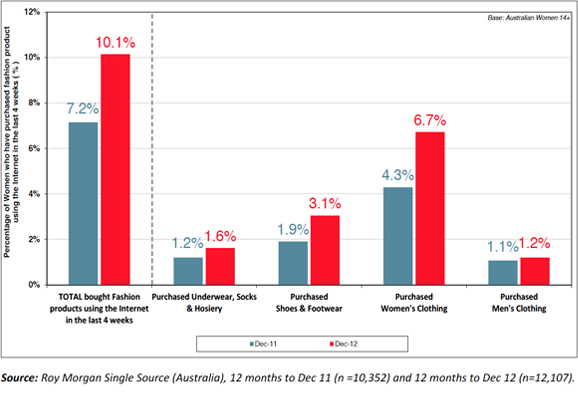
What is really interesting is the opportunities for marketers this research reveals. Most people would probably jump to the conclusion that these online sales are being lost by Australian stores because clothes are available cheaper from overseas. Everything on the web is cheaper, right? Well actually, no.
Roy Morgan’s research has found “scoring a bargain is not the main motivation for women purchasing fashion products online. Far more important is quality, with 75% of them agreeing with the statement ‘I believe quality is more important than price’.”
Discretionary spending by women on clothes has parallels with the way men seek financial advice. A recent national survey by an independent network of financial advisors found the vast majority of customers were more concerned about the quality of service and the frequency of face-to-face time they received than the size of the fee. Of hundreds of customers surveyed, price was rarely mentioned. Value was the primary concern, and the value equation was grounded in the perception of the quality of advice. .
None of this is new. I’ve been segmenting customers using the New Economic Order for nearly two decades since it was first developed by two Australian academics.
Evidence 2: choose who you want to be your customer
You can segment the population by three distinct sets which allow marketers to predict discretionary spending behaviour. The biggest segment, the Traditionals, sre generally cash poor with most of their spending accounted for with essential services, utilities bills, rent, transport and food. They have neither the capacity nor the predisposition to purchase discretionary items.
The other half has a common mindset, they share a desire to buy quality goods and experiences. This group is divided in half by their capacity to spend, one half are NEOs, and while they are only a quarter of the population they represent half all discretionary spending. Transitionals are NEOs on a limited budget: a career couple with one at home with a baby, or a high achiever that's just started their own business, or perhaps they have retired.
For 50% of consumers, the Traditionals, a cheap price is their opening and closing consideration. However these are the people who don’t spend much. They also deliver no sense of loyalty and don’t refer new customers. Every sale to a Traditional is a new sale that starts from scratch. And risks going to the lowest priced competitor on the day.
Most restaurant and airline customers and B2B purchasers are NEOs. These people research purchase decisions on the basis of what they believe are the features and benefits that mean the most to them. Price comes LAST, and isn’t much of a deal breaker.
Those latest stats on online fashion sales make sense in light of NEO behaviour. NEOs are online researching what’s hot in the world of fashion. In fact, it’s where they do most research when considering any major purchase because it’s where they control the levers, avoiding the unsavoury hassle of being sold by a salesman face to face. While Traditionals continue to spend the majority of their clothing budget on essential items like socks and undies in stores when the sales are on, NEOs continue to buy more discretionary fashion items, more often, both from the Internet and instore.
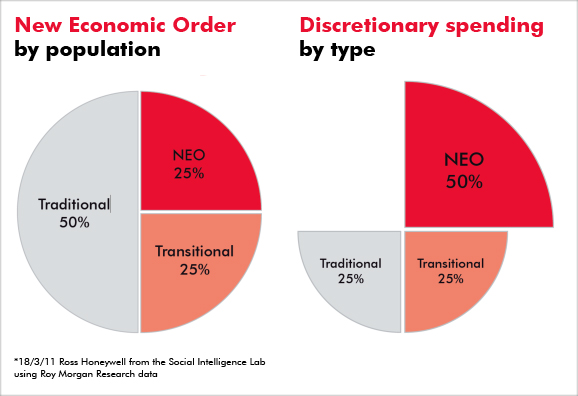
So what’s the best marketing model for selling to NEOs?
Evidence 3: all value is subjective
According to Ron Baker, the founder of Californian think tank the VeraSage Institute there are two fundamental approaches to pricing:
Cost-Plus Pricing
Labour Theory of Value
Product » Cost » Price » Value » Customers
Pricing On Purpose
Subjective Theory of Value
Customers » Value » Price » Cost » Product
You can see how subjective value pricing turns the order of cost-plus pricing on its head, by starting with the ultimate arbiter of value – the customer. In Baker’s words: “Goods and services do not magically become more valuable as they move through the factory and have costs allocated to them by cost accountants. The costs do not determine the price, let alone the value. It is precisely the opposite; that is, the price determines the costs that can be profitably invested in to make a product desirable for the customer, at an acceptable profit for the seller.”
As a marketer, for decades I found software one of the simplest products to approach from the Pricing On Purpose model; it’s the only reason Microsoft had education, standard and professional versions. The mid range product best reflects a fair margin for the cost of production of the product. The same product is then also sold at a low entry price with a few features turned off to maximise sales volume at the low end and repackaged in a fancy big box with a few extra features to maximise margin at the upper end of the market.
Choose who you want your customer to be, only then pick a marketing P
Whether you are selling clothes or cars, fair trade coffee or boutique wine, building materials or investment services, remember when your sales force wants you to discount, ask them to stop and think about the customer. Are you selling a basic product to a student, an authentic experience to a Transitional or a professional service to a NEO? Agree with sales who your customers are before you decide to use the PRICE lever.
Depending on who your customer is, Product, Place or Promotion may be more valuable to them than Price.
Read More

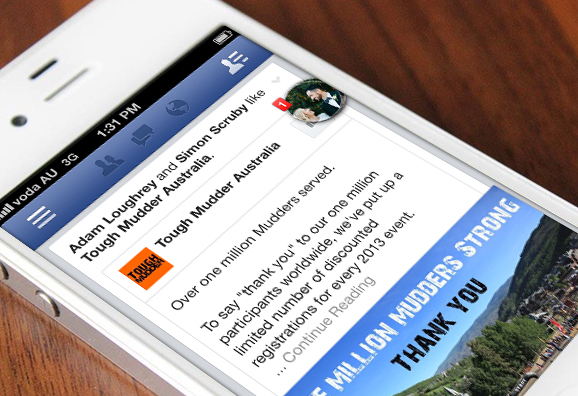
Just being active on Facebook isn’t enough. As with any communications medium, there are smart ways to achieve more for less effort.
Don’t be baffled by social media marketing spin doctors. Sure, Facebook has it’s own set of best practices. Hopefully by getting to know what matters and what doesn’t you can ensure any supplier will make the most of your investment.
The key to making the most of Facebook for your business is understanding it’s all about making sure everything you do improves your chances of being seen.
Much of this isn’t about paying for black art, it’s about basic step by step craft.
40% of time on Facebook is spent on news feeds
Only 12% is spent on profile or brand pages. So:
- Post articles on other people’s pagesPost on less pages more often
- Choose pages with high numbers of fansPhotos have higher ranking than links or text
- Use images
- Keep your text posts short – between 100 to 250 characters get 60% more engagement
- Ask a question
- Post daily and frequently
- Post about relevant topics – don’t push the brand
- Test your audience for their engagement times – 18-24 year olds are most active 9pm – 10pm, women 25-45 even later
How edge-ranking works is the key for marketers
All of these individual steps are only important because of something called edge-ranking. This makes or breaks social media marketing. This infographic shows how it works.
Read MoreThe health checklist for your sales process

15 questions to help your business determine the focus for your sales activity.
Do you have a sales department? Here are 15 questions to help change your sales force from sales takers to sales makers:
- How much time are you investing in new business a day?
- Is the total revenue and the sum of your clients’ budgets growing more slowly than in the past?
- Will growth levels come from present client budgets?
- Where will growth come from?
More frequency of purchase
More volume of each sale
More value? Up sell/or cross sell? - Will growth have to come from new business won from competitors?
- How do you sell to prospective clients?
- What’s your process?
- How do you find them?
- How do you win them?
- How do you prioritise sales calls?
- How is a sales call pre-qualified, (telesales/email/CRM)
- How long is spent face to face?
- What is your conversion rate?
- Is the sales call to the final decision maker?
- Who is the primary decision maker, how are they managed?
ROI marketing can help improve the performance of any of these sales metrics.
Marketing can speed sales, pre-qualify and build loyalty once you’ve made a sale.
In the past business owners were frustrated by an inability to measure what worked and what didn’t. Today there are tools and technques to enable you to measure the return on your marketing investment.
Read More


Scan the QR code for our contact details.
Download the Neoreader app.
© COPYRIGHT 2013 UNO marcomms Privacy